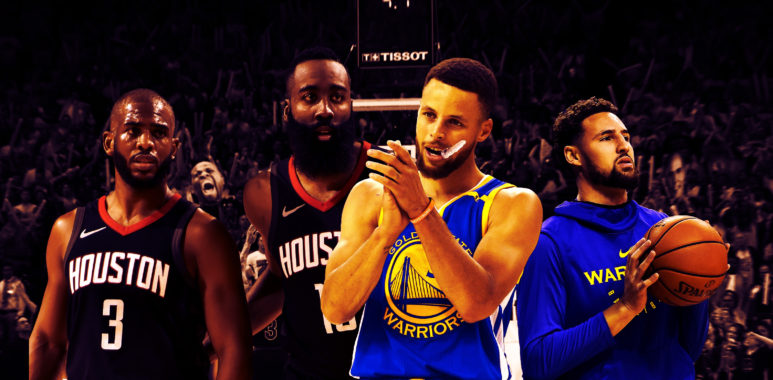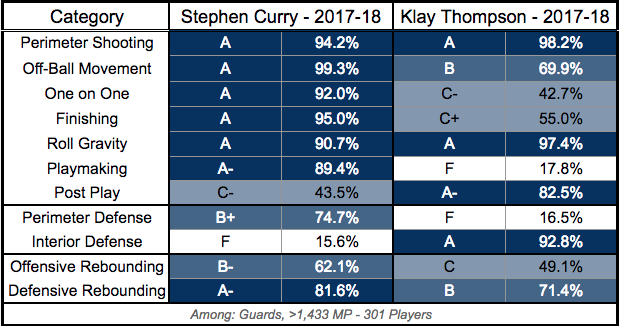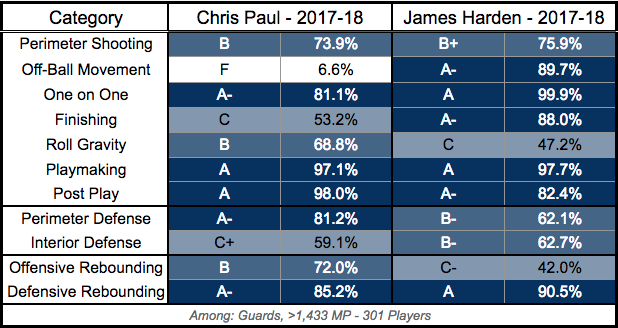
Examining the Gap Between the League’s Best Backcourts
Comparing the Best Backcourts the West, and the NBA, Have to Offer
Whether fans and sports media pundits like it or not, there are two realities that dominate the landscape of the NBA. One, the Golden State Warriors remain the best team in the league. Two, the guards drive the game as we know it.
Obviously, the “splash brothers” tandem of Stephen Curry and Klay Thompson make more than a compelling case for the best backcourt in the NBA. They are the champs, and their exceptional play has impacted the game to such a degree that opposing teams have shifted entire playing styles in an attempt to emulate the same spacing and perimeter shooting formula the Warriors have dominated with.
On the other hand, Houston’s James Harden and Chris Paul make an equally compelling case for best backcourt. The tandem powered the Rockets to the best record in the league last season, and pushed the Warriors to Game 7 in the Western Conference Finals. One may argue that the gap between the two backcourts is very slim.
Through the use of several impact and efficiency metrics, we can better judge the gap in production and impact between the backcourts. For this comparison, we’ll use Cranjis McBasketball‘s Points Over Expectation (POE), Jacob Goldstein‘s Player Impact Plus Minus (PIPM), and ESPN’s Real Plus Minus (RPM). We’ll contrast those impact and efficiency metrics with our offensive and defense BBall Index player grades from 2017-18, which analyze talent levels in skill sets rather than impact.
Through each of these lenses, let’s see what, if anything, separates the two most dynamic backcourts in the NBA.
Offensive Comparison
The talent grades developed at BBall Index allow us to take inventory of how each backcourt stacks up from a skill set standpoint.
It’s important to note that these percentiles and grades are compared to a peer group of starting guards from the years 2013-2018. Our metrics categorize Klay as a wing, but we’ll group him in with the guards for this piece.
Also worth noting is that Thompson’s A- Post Play grade means he’s a great post player among those starting guards, not all players. Similarly, his F level Perimeter Defense raises to about average vs all players.

As you can see, both Curry and Thompson have a decided advantage over the Rockets’ backcourt when it comes to Perimeter Shooting. The Warriors’ use of both players as screeners leading into popping actions looking for shots also impacts their Roll Gravity grades, which typically aren’t important or impressive for guards.

Both backcourts have become dominant forces in the NBA, as outlined below in the impact stats. But the style and deployment of that production is different, and fits the skill sets for both groups well.
Paul and Harden create with elite One on One and Playmaking abilities, predicated on excellent ball handling and ball dominance.
Curry and Thompson starkly contrast this style, with their emphasis on shooting and movement off-ball creating opportunities for themselves and others, through the immense gravitational pull their perimeter shooting creates on the defense.
And both styles yielding positive results is clearly seen in the impact stats. The percentiles provided are compared to all players, not just guards.
The edge for offensive POE (CPOE) is a push between Harden and Curry both better than over 99% of the league. Both guards are such prolific and dynamic scorers even if their approach to offense is different. It’s no secret that Harden is a ball dominant while Curry wrecks defenses off the ball. Judging from the results and the stats from last season, neither approach is wrong and both can contribute to high level offense.
A look at O-PIPM finds another tie between Curry and Harden at the top, while Paul is only better than 99 percent of the NBA and Thompson at 91 percent. Again, Curry and Harden best every other player int the league because of their offensive skill set of creating their own shots and gravity being paired with offensive systems which augment those skills. Paul’s court vision and his ability to score makes him not far behind. As far as Thompson goes, more often than not, he’s spotting up. He’s not as much of a One on One or driving threat (yet), and that’s the difference.
The ORPM edge goes to Curry in the 99.9th percentile. Paul trails him in the 99th percentile. Harden’s ORPM isn’t far behind, with it painting him as more positively impactful on offense than 98 percent of his pro peers. Thompson again grades out lower than the other three guards, with an ORPM in the 90th percentile.
Defensive Comparison
On the other side of the court, Chris Paul holds the advantage over his peers in every stat as an overall and perimeter defender, and in several cases it’s not particularly close.
In terms of the impact and efficiency stats stats, CP3 grades out better than 90% (DPOE), 88% (D-PIPM), and 67% (DRPM) of the NBA. The other three players don’t come close to Paul in DPOE or D-PIPM, hovering in the low 50s percentiles and mid 50s percentiles for those two stats, respectively. Paul’s elite Perimeter Defensive player grade and above average interior grade solidify his standing above these other three.
In the case of Harden, Curry, and Thompson, I believe it’s a case of people seeing what they want to defensively.
Harden may have the potential to be a solid defender, but only when he’s motivated. Two B- talent grades defensively and a good Defensive Rebounding grade compared to this peer group highlight that potential output. But we also have several Shaqtin’ a Fool level defensive plays seared into our minds from the past several years. As a whole, his defensive output and impact has been about average.
Curry tries to make an effort defensively, he struggles with his own tendencies more so than his size. He has a nasty habit of playing defense with his arms rather than his feet. His inability to defend the interior contrasted with his B+ Perimeter Defense allows us to see the good and the bad within the course of just a couple possessions.
Thompson’s defense is a second thought for many because of his offense, but he’s no pushover either. But grading out so well on the interior and poorly as a perimeter defender relative to his high volume guard peers creates yet another opportunity for the performance perceived by fans to vary.
Another component of the output in impact stats compared to the talent grades is defensive scheme. For Golden State, these numbers correlate with their role in the system. The Warriors are about the switch and Curry’s strongest suit on defense is that he is a solid help defender. Thompson’s defense is bolstered in the Warrior scheme since he guards switches well. On the other hand, Paul is solid individually on the perimeter and also as a help defender, making him a good fit just about anywhere. His only major weakness is getting stuck on bigs on switches.
Overall Comparison
Rating players in terms of overall talent is difficult, since the weighting of each component will never quite satisfy everyone. But teams taking what players have in skill set and finding roles and schemes to fit those skill sets gets us to overall impact, which we can compare.
You can very well argue that theres not really a POE advantage for the splash brothers nor is there an advantage for Harden and CP3. Both backcourts are dominant and dynamic in this regard.
However, the edge for overall Points Over Expectation goes to Curry. His overall POE was best in the NBA last season, while Harden and Paul are a tick below having POE values better than 99% of the NBA. Thompson’s POE tops 94% of the NBA. What separates Curry from Harden and Paul is the gravity that Curry creates in the Warrior’s offense versus a more iso style employed by the Rockets. Curry’s gravitational pull is the main ingredient in the Warriors’ pass happy motion offense. Curry’s shooting prowess and the attention that it brings is a catalyst of the Warriors leading the league in assists last season.
It’s a push between Curry and Paul for Player Impact Plus Minus (PIPM) and rightfully so. Both rated at the top of the league, Curry and Paul’s impact is felt when they are out on the floor. Again, Curry’s gravitational pull on offense opens up opportunities for everyone on the floor to score, which is why this man’s plus and minus numbers have been astronomical during the past four seasons. Paul impacts the game not only with his defense, but with his court vision. In a league full of scoring point guards, Paul is the last of the “pure” point guards, where being a distributor and facilitator takes precedence over the scoring. Granted, Paul was ball dominant as a Clipper, but as a Rocket, Harden’s ball dominance free’s Paul up to be more of a facilitator. Why else did this duo worked unbelievably well last season? It’s because of Paul’s impact.
Defense separates Golden State and Houston in Real Plus Minus. Harden and Paul sports an overall RPM of 100 percent each, while Curry ‘s is 99 and Thompson is at 89 percent. Offensively, the RPM edge goes to Curry at 100 percent but his DRPM is at 47. Harden’s RPM on offense is 98 percent while his defense is 59. Paul once again dominates on defense at 67 percent.
To sum it up, judging from last years numbers with this system, there is still a compelling argument for the best backcourt in the league it is a tie between these backcourts. What will push either of them over the top is unknown, but the fun is in watching and enjoying the excellence each backcourt brings to the court.
